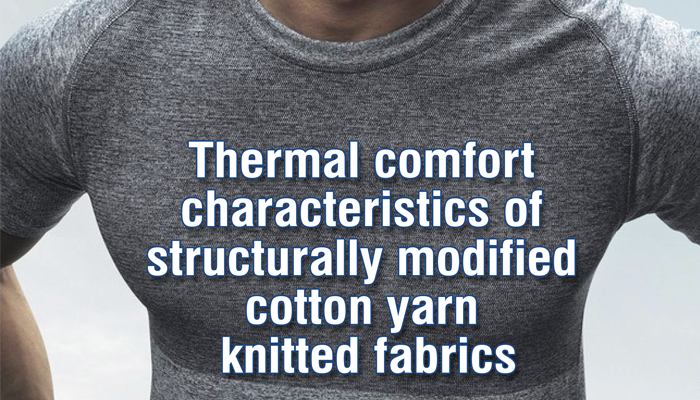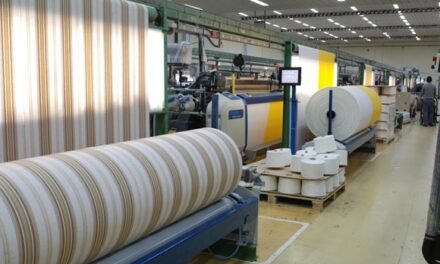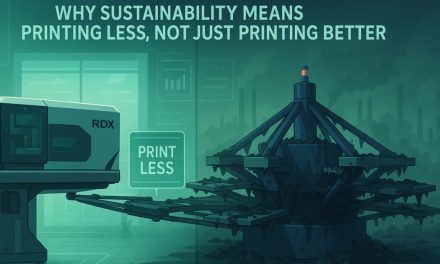Thermo physical properties
Results of various thermo physical properties such as thermal resistivity, thermal conductivity, thermal diffusivity, thermal absorptive and peak heat flow density of knitted fabrics are presented in Table 3.
Thickness
From the thickness values of the knitted fabrics it is understood that modified yarn fabric is thicker than normal yarn fabric. Due to the removal of polyester core component from the yarn structure after knitting, many pores (air-rich) have been developed in the yarn structure (Figures 1 and 2), which has reduced the packing density in the core of the yarn. Hence there is an improvement in the bulkiness of the yarn. Differences in the thickness values arise out of the reduced fibre packing density in the core of the modified yarn and improved bulkiness of the modified yarn.
Thermal resistance
From the results, it is understood that the thermal resistivity of modified yarn fabric is higher than that of the normal yarn fabric. This is due to the increased thickness of the modified yarn fabric.Since thickness of modified yarn fabric is higher than that of normal yarn fabric, it offers more resistance to the passage of heat. Also due to the increased entrapped air (air-rich) in the yarn centre thermal resistivity of modified yarn fabric is higher than that of the normal yarn fabric. Air is a poor conductor of heat. Increasing the entrapped air in the yarn makes it more suitable from the stand point of thermal comfort. Because of the removal of polyester core component from the yarn structure after knitting, inter-fibre space is enhanced in the yarn structure (Figures 1 and 2). The increased entrapped air in the yarn increases thermal resistivity making the yarn warmer in hand and bulkier.
Thermal conductivity
From the results it is understood that the thermal conductivity of modified yarn fabric is lower than that of normal yarn fabric. This is due to the increased entrapped air (air-rich) in the yarn centre. Increasing the entrapped air in the yarn makes it more suitable from the stand point of thermal comfort. Because of the removal of polyester core component from the yarn structure after knitting, inter-fibre space is enhanced in the yarn structure (Figures 1 and 2). The increased entrapped air in the yarn reduces thermal conductivity making the yarn warmer in hand and bulkier. Because of the increased thickness thermal conductivity of the modified yarn fabrics is reduced.
Thermal diffusion
Thermal diffusion is an ability related to the heat flow through the air in the fabric structure. The thermal diffusivity of modified yarn knitted fabric is higher than that of the normal yarn knitted fabric. This is because of highly porous nature of the modified yarn knitted fabrics and the presence of large amount of air in the yarn structure (Figures 1 and 2). This is evident from the thermal resistance values. Reduced fabric packing factor, increased porosity (air-rich) of the structure and presence of large amount of air in the structure facilitates thermal diffusion.
Thermal absorption
Thermal absorption is a surface property which allows the fabric’s character to be assessed with regard to its warm cool feeling i.e., the feeling obtained when the human skin briefly touches any object such as textile material. Fabrics with a low value of thermal absorption gives ‘warm’ feeling, whereas those with a high value of the thermal absorption gives ‘cool’ feeling. Thermal absorption is a transient parameter which depends neither on the temperature gradient between the fabric and skin, nor on the measurement time. It is not an instrument parameter, but a real textile characteristic. From the test results it is understood the thermal absorptivity of modified yarn knitted fabric is lower than that of normal yarn knitted fabric. Lower thermal absorptivity of modified yarn knitted fabric can be attributed to lower thermal conductivity which in turn was influenced by reduced fabric packing factor, increased porosity (air-rich) of the structure and presence of large amount of air in the yarn structure.
Peak heat flow density
The peak heat flow density ‘qmax’ appears at the moment that the cold fabric contacts the hot plate of the Alambeta device. Over the time, the heat flow stabilises itself at a specific level ‘qs’, which is called the stationary heat flow density. The ratio of the maximum and stationary heat flow density ‘p’ is one of the parameters which characterises the thermal insulation of fabric, and similar to thermal absorption, it is a surface property. From the results it is inferred that peak heat flow density is higher in the case of modified yarn knitted fabrics when compared to normal yarn knitted fabrics. This can be attributed to the bulky yarn structure, reduced fabric packing factor, increased porosity(air-rich) of the structure and presence of large amount of air in the yarn structure (Figures 1 and 2).
On the basis of the presented results, higher value of the ratio of the peak and stationary heat flow density is observed in the case of modified yarn knitted fabric than normal yarn knitted fabric. Higher value of the ratio of the peak and stationary heat flow density arises out of higher peak heat flow density. This indicates that modified yarn fabric exhibits better thermal insulation than normal yarn knitted fabric.
Air and moisture transfer properties
Results of air permeability, water vapour permeability, wettability wicking and water absorbency of knitted fabrics are presented in Table 4.
Air permeability
All textile fibres irrespective of the their chemical composition are impermeable to air, and the passage of air through a fabric can only take place through the pores in the fabric, that is, through the spaces between fibres. The air permeability of a fabric is therefore dependent almost entirely on the structure of fabric and the yarn or fibre assembly, and is practically independent of the type of fibre used.
From the results it is understood that modified yarn fabric has higher air permeability than normal yarn fabric. Even though the modified yarns are thicker and bulkier the modified yarn fabrics exhibit better air permeability than normal yarn knitted fabrics. This may be attributed to the higher inter-fibre porosity (air-rich) of the modified yarn structure (Figures 1 and 2).
Variations in the air permeability values of modified yarn and normal yarn fabrics are primarily a result of differences in fabric packing factor. Modified yarn fabric has lower fabric packing factor, increased porosity of the structure and presence of large amount of air in the yarn structure (air-rich) when compared to normal yarn fabric. Differences in fabric packing factor and porosity of the modified yarn fabric has contributed to variations in the air permeability values of modified yarn and normal yarn fabrics.
Water vapour permeability
Water vapour permeability is an important parameter in evaluating comfort characteristics of a fabric, as it represents the ability to transfer perspiration coming out of the body. Test results reveal that modified yarn fabrics have higher water vapour permeability than normal yarn fabric. This may be attributed to the bulky structure of modified yarn. Modified yarn fabric has lower fabric packing factor, increased porosity (air-rich) of the structure and presence of large amount of air in the structure. Yarn structure plays an important role in the transmission of water vapour. Open structure allows more water vapour transmission. Modified yarns have a better cover factor which allows water vapour transfer from inside to outside through diffusion. When the transmission occurs through pores, the rate is independent of water vapour concentration. A larger amount of liquid mass can be retained in larger pores, which facilitates the diffusion process from inner region to outer region.


Wettability
Wetting and wicking are important phenomenon in the processing and applications of fibrous materials. Wetting and wicking behaviour of fibres is important to describe fluid transport in fibrous media. Wetting is the displacement of a fibre-air interface with a fibre-liquid interface. Wicking is the spontaneous flow of a liquid in a porous substrate, driven by capillary forces. Because capillary forces are caused by wetting, wicking is a result of spontaneous wetting in a capillary system. Wetting and wicking processes occurring during wearing of clothes have a practical significance in clothing comfort.
From the wettability results it is understood that modified yarn fabric exhibits better wettability than normal yarn fabric. This may be due to reduction in surface free energy of the modified yarn. Lower surface free energy of the modified yarn facilitates wettability. Treatment with m cresol reduces surface free energy of modified yarn fabric and enhances its wettability.
Wicking
Wicking is the spontaneous flow of a liquid in a porous substrate, driven by capillary forces. Because capillary forces are caused by wetting, wicking is a result of spontaneous wetting in a capillary system. Wicking property of a fabric mainly depends on characteristics of fibre and structure of component yarns and the fabric.
From the results it is understood that modified yarn fabric shows higher wicking in both wale and course directions than normal yarn knitted fabric in all time intervals. Wicking can only occur when fibres assembled with capillary spaces between them are wetted by a liquid. Capillary forces are responsible to drive the liquid in capillary spaces. The fibre surface properties and pore structure are the main determinants of wicking properties. The capillary principle dictates that smaller pores are filled first and are responsible for the front movement of the liquid. As the smaller pores are completely filled, the liquid then moves to the larger pores. The size and spaces of fibre as well as their alignment will influence the topology of the inter-fibres spaces or pores, which are channelled with widely varying shape and size distributions.
Higher wicking of modified yarn fabrics could be attributed to more inter-fibre spaces (air-rich) in the modified yarn structure. The modified yarn fabric has lower packing factor, increased porosity (air-rich) and presence of large amount of air in the structure when compared to normal yarn. Larger than optimum pores will slow down entry due to low capillary pressure.
Optimum capillary size will cause faster entry of water into the yarn pores. Higher wicking of modified yarn fabrics reveals that there exist optimum pores in the modified yarn fabrics. This is supported by images of cross-section of modified yarn which shows more inter-fibre space in the yarn structure. Due to the dissolution of the core component more voids (air-rich) were developed in the modified yarn structure.
Water absorbency
Water absorbency of a fabric mainly depends on the moisture regain of component fibre and open space within the fabric structure, and is an indication of sweat holding capacity of the fabric. Amount of voids within the structure of fabric plays an important role in water absorbency. Test results reveal that water absorbency of modified yarn fabric is very much higher than that of normal yarn fabric. This may be attributed to the bulky structure of modified yarn. The modified yarn fabric has lower packing factor, increased porosity (air-rich) and presence of large amount of air in the structure when compared to normal yarn. Water replaced air in the modified yarn structure and thus it can hold more water.
Conclusions
This work focused on development of structurally modified cotton knitted fabrics by reducing fibre packing and increasing air pockets (porosity) in the yarn structure and studying their geometrical, thermal, air and moisture transfer characteristics, by removing the core component of cotton covered polyester core-spun ring yarns after knitting. Based on the study of geometrical parameters such as yarn count, stitch length, wales per centimetre, and courses per centimetre, stitch density, tightness factor, areal density, spirality, fabric packing factor and porosity, dimensional parameters such as Kw, Kc, Ks and loop shape factor, and yarn cross-section of normal and modified cotton yarn knitted fabrics it is concluded that modified yarn fabrics exhibit less spirality, lower fabric packing factor, higher porosity, stable loop configuration and lighter in weight compared to normal yarn knitted fabrics.
From the study of thermo physical properties such as thermal resistivity, thermal conductivity, thermal diffusivity, thermal absorptivity, peak heat flow density and peak heat flow density ratio of normal and modified cotton yarn knitted fabrics it is concluded that modified cotton yarn knitted fabrics give better thermal insulation and warmer feeling when compared to normal yarn knitted fabrics. Study of air and moisture transfer properties such as air permeability, water vapour permeability, wettability, wicking height (1 minute, 3 minutes and 5 minutes) and absorbency of the knitted fabrics concluded that modified yarn knitted fabrics has better air permeability, water vapour permeability, wettability, wicking and absorbency than normal yarn knitted fabrics. Based on this work, it is concluded that structurally modified cotton knitted fabrics offer better thermal comfort characteristics and can be used to develop functional textile or apparel products for suitable end uses.






















